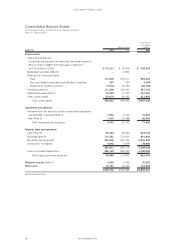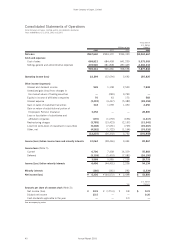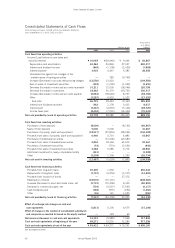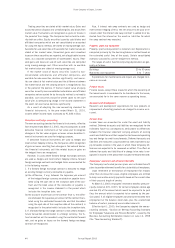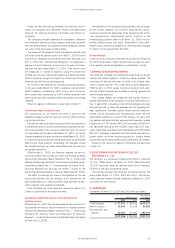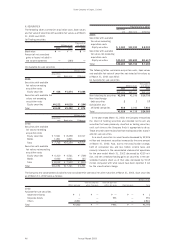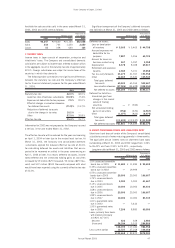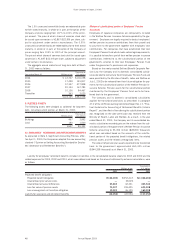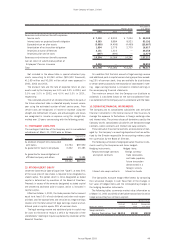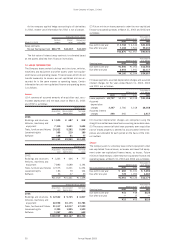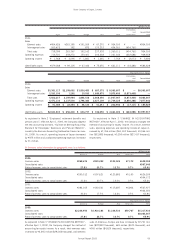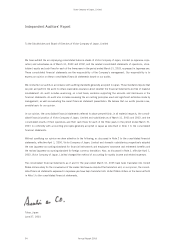JVC 2003 Annual Report Download - page 47
Download and view the complete annual report
Please find page 47 of the 2003 JVC annual report below. You can navigate through the pages in the report by either clicking on the pages listed below, or by using the keyword search tool below to find specific information within the annual report.
Victor Company of Japan, Limited
Annual Report 2003 45
Under the New Accounting Standard, the liabilities and ex-
penses for severance and retirement benefits are determined
based on the amounts actuarially calculated using certain as-
sumptions.
The Company provided allowance for employees’ severance
and retirement benefits as of the balance sheet dates based on
the estimated amounts of projected benefit obligation and the
fair value of the plan assets at those dates.
The excess of the projected benefit obligation over the total
of the fair value of pension assets as of April 1, 2000 and the
liabilities for severance and retirement benefits recorded as of
April 1, 2000 (the “net transition obligation”) is recognized in
expenses in equal amounts primarily over 15 years commenc-
ing with the year ended March 31, 2001. Prior service costs
are recognized in income or expenses using the straight-line
method over 10 years, and actuarial gains and losses are recog-
nized in expenses using the straight-line method over 10 years
commencing with the succeeding period.
As a result of the adoption of the new accounting standard,
in the year ended March 31, 2001, severance and retirement
benefit expenses increased by ¥595 million, and income be-
fore income taxes decreased by ¥557 million compared with
what would have been recorded under the previous accounting
standard.
Effect on segment information is described in Note 15.
Amounts per share of common stock
The computation of net income per share is based on the
weighted average number of shares of common stock outstand-
ing during each year.
Diluted net income per share assumes dilution that could occur
if convertible bonds or similar securities were converted into com-
mon stock resulting in the issuance of common stock. As a result
of computation for the year ended March 31, 2001, and as the
Company reported net losses for the year ended March 31, 2002,
inclusion of potential common shares would have an antidilutive
effect on per share amounts. Accordingly, the Company’s basic
and diluted earnings per share computations are the same for
the periods presented.
Effective April 1, 2002, the Company adopted the new ac-
counting standard for earnings per share and related guidance
(Accounting Standards Board Statement No. 2, “Accounting
Standard for Earnings Per Share” and Financial Standards Imple-
mentation Guidance No. 4, “Implementation Guidance for Ac-
counting Standard for Earnings Per Share”, issued by the
Accounting Standards Board of Japan on September 25, 2002).
The effect on earnings per share of the adoption of the new
accounting standard was not material. Such amounts for the
years ended March 31, 2002 and 2001 have not been recalcu-
lated using the new accounting standard.
Cash dividends per share represent the actual amount de-
clared as applicable to the respective years.
Accounting standard for treasury stock and reversal of
statutory reserves
Effective April 1, 2002, the Company adopted the new account-
ing standard for treasury stock and reversal of statutory reserves
(Accounting Standards Board Statement No. 1, “Accounting
Standard for Treasury Stock and Reduction of Statutory
Reserves”, issued by the Accounting Standards Board of Japan
on February 21, 2002).
The adoption of the new accounting standard had no impact
on net income. However, as a result of adopting this new ac-
counting standard and application of the related revised disclo-
sure requirements, stockholders’ equity accounts in the
accompanying balance sheet as of March 31, 2003 are pre-
sented differently from prior years. Presentation of the stock-
holders’ equity accounts as of March 31, 2002 has been changed
to conform to the presentation for 2003.
Reclassifications
Certain prior year amounts have been reclassified to conform to
the 2003 presentation. These changes had no impact on previ-
ously reported results of operations or stockholders’ equity.
3. CHANGE IN ACCOUNTING METHOD
The Company changed the method of accounting for royalty
income and related expenses. Under the former method, the
net amount of the two items was included in the income state-
ment as royalty income—net, under other income (expenses).
Effective April 1, 2002, royalty income is included in net sales,
and the related expenses are included in selling, general and
administrative expenses.
This change reflects the recognition that royalty income is
directly attributable to the Company’s principal operating activi-
ties, in light of the increasing number of technological alliances
with partners both in Japan and overseas, and their growing stra-
tegic significance. Therefore, royalty income and the related ex-
penses will be disclosed more appropriately under the new
presentation method. As a result of the change, net sales, sell-
ing, general and administrative expenses and operating income
increased by ¥7,356 million ($61,300 thousand), ¥4,066 mil-
lion ($33,883 thousand) and ¥3,290 million ($27,417 thou-
sand), respectively, and other income decreased by ¥3,290 million
($27,417 thousand), compared with what would have been re-
ported under the former accounting policies. Income before
income taxes and minority interests was unaffected by this change.
Details of the impact on segment information are described
in Note 15.
4. RELATIONSHIP WITH MATSUSHITA ELECTRIC
INDUSTRIAL CO., LTD.
The Company is a subsidiary of Matsushita Electric Industrial
Co., Ltd. (“Matsushita”). At March 31, 2003, Matsushita held
133,227 thousand shares of common stock of the Company,
52.40% of the total outstanding shares.
Transactions between the Company and Matsushita for the
years ended March 31, 2003, 2002 and 2001, and the ac-
count balances between the two companies at March 31, 2003
and 2002 are not material.
5. INVENTORIES
Inventories at March 31, 2003 and 2002 were as follows:
Thousands of
Millions of yen U.S. dollars
2003 2002 2003
Finished goods ¥ 77,378 ¥ 85,815 $644,817
Work in process 10,391 13,166 86,592
Raw materials and
supplies 23,487 27,082 195,724
¥111,256 ¥126,063 $927,133





